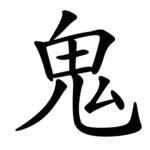Radical 194
Radical 194 or radical ghost (鬼部) meaning "ghost" or "demon" is one of the 8 Kangxi radicals (214 radicals in total) composed of 10 strokes.
| 鬼 | ||
|---|---|---|
| ||
| 鬼 (U+9B3C) "ghost, demon" | ||
| Pronunciations | ||
| Pinyin: | guǐ | |
| Bopomofo: | ㄍㄨㄟˇ | |
| Wade–Giles: | kuei3 | |
| Cantonese Yale: | gwai2 | |
| Jyutping: | gwai2 | |
| Japanese Kana: | キ ki (on'yomi) おに oni (kun'yomi) | |
| Sino-Korean: | 귀 gwi | |
| Hán-Việt: | quỷ, khuỷu, quẽ, quỉ | |
| Names | ||
| Japanese name(s): | 鬼/おに oni 鬼繞/きにょう kinyō | |
| Hangul: | 귀신 gwisin | |
| Stroke order animation | ||
 | ||
鬼 (9 strokes in Simplified Chinese) is also the 184th indexing component in the Table of Indexing Chinese Character Components predominantly adopted by Simplified Chinese dictionaries published in mainland China.
Evolution
 Oracle bone script character
Oracle bone script character Bronze script character
Bronze script character Large seal script character
Large seal script character Small seal script character
Small seal script character
The character is historically composed of 儿 "legs", 田 representing a large demon's head and a curl looking similar to 厶 taken to represent a swirl of vapour, or a demon's tail.
The character can be traced to the oracle bone script, where it depicts a man kneeling on a monster head.
Derived characters
| Strokes | Characters |
|---|---|
| +0 | 鬼 |
| +3 | 鬽 (=魅) |
| +4 | 鬾 鬿 魀 魁 魂 |
| +5 | 魃 魄 魅 魆 |
| +6 | 魇SC (=魘) |
| +7 | 魈 魉SC (=魎) |
| +8 | 魊 魋 魌 魍 魎 魏 |
| +10 | 魐 |
| +11 | 魑 魒 魓 魔 |
| +12 | 魕 魖 |
| +14 | 魗 魘 魙 |
Most of the characters derived from the radical have meanings related to ghosts or souls, including 魔 "devil, demon", 魑 "black magic", 魘 "nightmare", 魄 "soul". In some signs, however, the radical is present purely as a phonetic marker, for example in 魏, the State of Wei during the Spring and Autumn period.
Variant forms
| Kangxi Dict. Trad. Chinese (TW/HK/MO) Japanese Korean | Mainland China |
|---|---|
| 鬼 | 鬼 |
Literature
- Fazzioli, Edoardo (1987). Chinese calligraphy : from pictograph to ideogram : the history of 214 essential Chinese/Japanese characters. calligraphy by Rebecca Hon Ko. New York: Abbeville Press. ISBN 0-89659-774-1.
- Li, Leyi: “Tracing the Roots of Chinese Characters: 500 Cases”. Beijing 1993, ISBN 978-7-5619-0204-2
- Harbaugh, Rick, Chinese Characters: A Genealogy and Dictionary, Yale University Press (1998), ISBN 978-0-9660750-0-7.
- Childs-Johnson, Elizabeth (江伊莉), 甲骨文的“鬼”与假面具 (The Gui-Spirit in Oracle Bone Inscriptions), International Conference Celebrating the 95th Anniversary of the Discovery of Oracle Bone Inscriptions", Anyang, China, 1994.